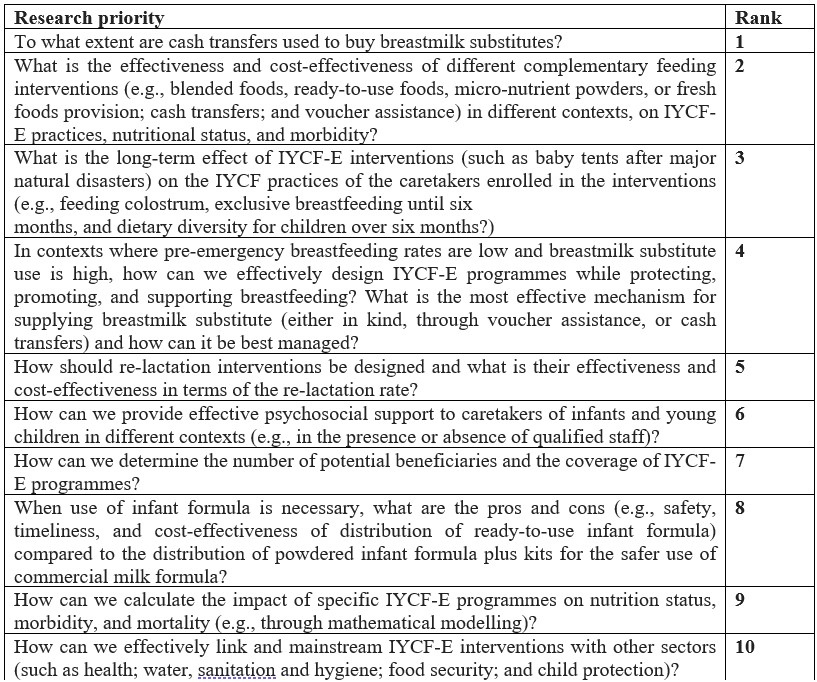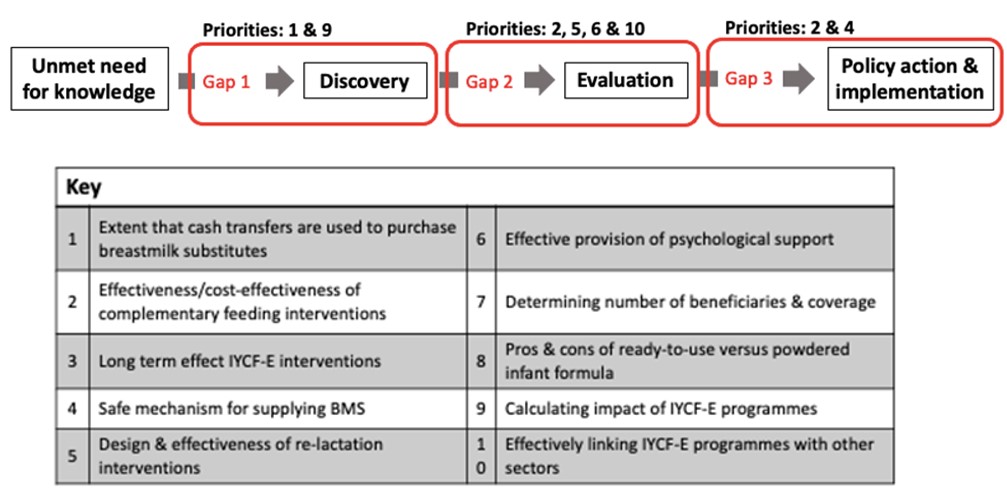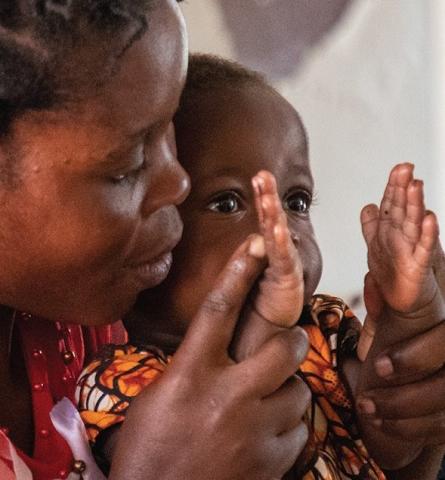Research priorities for infant and young child feeding in emergencies
Kenya Addison is a development consultant in the Human Development Practice at Genesis Analytics.
This research article was adapted from an original student dissertation project titled “Ask any of us ‘can you show me the data?’ We barely have it: A qualitative study of research priorities on infant and young child feeding in emergencies”, which Kenya completed as part of the MSc Nutrition for Global Health course at London School of Hygiene and Tropical Medicine.
Background
What we know: A 2016 research prioritisation exercise distilled 10 research priorities concerning infant and young child feeding in emergencies (IYCF-E).
What this adds: This qualitative study explores the perceptions of IYCF-E practitioners to identify the relevance of these research priorities and whether there is a paucity of evidence or whether, instead, practitioners are simply not aware of evidence that already exists. Of the 10 research priorities, participants consistently found seven to still be relevant and their perceptions of the evidence aligned with the state of the evidence.
Fragile and conflict-affected nations experience an under-five mortality rate three times higher than the global average (UNICEF, 2023). Infants and young children are particularly vulnerable due to their specialised nutritional requirements, immature immune systems, and dependency on caregivers. Despite the need to conduct high-quality research on infant and young child feeding in emergencies (IYCF-E), there remains a lack of robust, empirical evidence in this area.
Recognising this gap, Prudhon et al (2016) conducted a research prioritisation exercise in consultation with 27 technical experts to identify the top 10 research priorities for IYCF-E (Table 1). To build upon their work, I conducted a qualitative study to explore the perceptions of those working in IYCF-E on the current research gaps and the relevance of these ‘top 10’ research priorities. This article summarises my findings.
Table 1: Top 10 research priorities for infant and young child feeding in emergencies

Adapted from Prudhon et al (2016)
Methodology
I conducted 13 remote, semi-structured interviews between 11 July and 5 August 2022. I identified participants through selective snowball sampling and reached data saturation when I gained no new information from interviewees. To identify whether there was a real lack of evidence or whether professionals were just unaware of existing evidence, I compared participant knowledge about these 10 IYCF-E priorities with a subsequent literature search.
I used thematic analyses to examine interviewee responses, organising first into themes, which were then disaggregated into sub-themes. I then used Pearson and Jordan’s framework (Figure 1) to guide the interpretation and presentation of the results. The framework outlines the different types of evidence needed in the process of evidence generation and translation of health-related research into implementation. Framing research priorities for IYCF-E within this framework served to organise and clarify where research should be targeted.
Figure 1: Evidence gaps in the knowledge translation framework

Adapted from Pearson et al (2012)
Results
Interviewees were of different ages and genders and came from a variety of research, policy, and programmatic backgrounds. All participants had a minimum of five years’ work experience in IYCF-E to ensure a valid sample of professional knowledge in this area.
Complementary feeding interventions
Research on the effectiveness and cost-effectiveness of complementary feeding interventions was consistently identified as being one of the top two research priorities by participants. Interviewees expressed how complementary feeding interventions had been previously neglected in IYCF-E research, with research primarily focused on breastfeeding.
”œComplementary feeding has been quite marginalised in the IYCF-E space. I think the focus really was on breastfeeding and formula feeding because it was so obviously urgent.” – Participant 9
How to effectively design IYCF-E programmes at the same time as protecting, promoting, and supporting breastfeeding
Research into mechanisms for the effective design of IYCF-E in settings where pre-emergency breastfeeding rates were low and commercial milk formula use was high was identified as one of the top two research priorities by 11 interviewees. Participants reflected on the fact that there is hesitancy to conduct research in this area.
”œI think people have been scared of commercial milk formula and tended to shy away from it.” – Participant 9
Cash transfers and commercial milk formula
A total of 10 interviewees reported that the extent to which cash transfers could be used to purchase commercial milk formula has not been sufficiently researched. However, all 10 of these interviewees felt the priority as it then stood would not provide useful information and should instead form part of a wider research priority – such as ”œHow could cash transfers be designed to effectively support IYCF-E?”
”œHow is that information going to be used? I think that needs to be more of a wider research priority” – Participant 3
Re-lactation interventions
A total of nine interviewees felt that the design, effectiveness, and cost-effectiveness of re-lactation interventions remained a research priority. Interviewees reflected that having more evidence on re-lactation would help to build confidence in its use in emergency settings.
”œThere’s still a lack of confidence in re-lactation and not many places where there's any sort of systematic programming. We definitely need more research to help people to be confident.” – Participant 9
Psychosocial support for caretakers
A total of four interviewees spoke directly to this and reported that the provision of effective psychosocial support remained a priority, stating that a caregiver’s psychological state can influence their ability to care for their child and impact their feeding practices.
”œI think, particularly how to support those mothers and caregivers, who are distressed, who feel that they need infant formula. But…really what they are needing is breastfeeding support. It is difficult. We don't really have a lot of evidence around it.” – Participant 9
Calculating the immediate impact of specific IYCF-E programmes
Although this was the least mentioned research question, all four interviewees who spoke about calculating the impact of IYCF-E programmes felt that it was still a priority as it provides vital information for advocacy efforts, particularly when approaching donors.
”œIt's important in terms of the evidence around the importance of our IYCF-E programmes, because we need it for advocacy – we need to continue raising the profile of IYCF-E programmes and investment”. – Participant 8
Calculating the long-term effect of IYCF-E interventions
Overall, the eight interviewees who spoke to this topic felt that the long-term impacts of IYCF-E interventions were not a research priority. Interviewees stated that it was more important to first study the short-term impact and that we were not yet at the stage of studying long-term outcomes.
”œWe absolutely are in desperate need of evidence that the interventions that we have in the operational guidance are effective and helpful in the long term.” – Participant 9
Coverage of IYCF-E programmes
All interviewees reported that research on how to calculate the coverage of IYCF-E programmes was not a research priority due to the increase in available tools and guidance.
Ready-to-use versus powdered infant formula
In total, 13 interviewees thought further research on ready-to-use versus powdered infant formula was not required, as learning was deemed to be available, and that ultimately the decision on which to use would be context specific and driven by what was available at the time.
Mainstreaming IYCF-E interventions
A total of 10 interviewees identified research on how to effectively mainstream IYCF-E interventions into other sectors as a research priority. Interviewees noted that there was operational guidance on this topic, but that more evidence was needed regarding its impact on IYCF-E outcomes.
”œWe have the UNHCR framework… I think it is a great framework to tell us what to do. I don't think we've necessarily researched it to say… is this effective?” – Participant 6
Discussion
The effectiveness and cost-effectiveness of different complementary feeding interventions and the safe supply of commercial milk formula were identified as the top research priorities. Commercial milk formula has been extensively distributed in emergencies in a harmful and unsolicited manner – with practitioner focus limited to preventing distribution, rather than exploring the mechanisms required for safe supply. UNICEF recently released guidance on the supply of commercial milk formula in emergencies (UNICEF, 2021), which showed welcome progress. However, participants highlighted the growing concern that commercial milk formula may be increasingly required in emergency situations and stated that they would like to see further evidence of how this has been safely implemented in different contexts.
The research priority regarding the extent that cash transfers are used to purchase commercial milk formula remains relevant and is unanswered. Since Prudhon et al (2016), several studies evaluated cash transfers and their impact on nutritional outcomes. However, none of these refer to commercial milk formula, which may be due to hesitancy in appearing to support it. Although this research question was not viewed as one of the most pressing priorities, future evaluations of cash transfer programmes may want to consider including this as an outcome, particularly as more emergencies are occurring in contexts with low rates of pre-emergency breastfeeding and high rates of commercial milk formula use.
Research on the design and effectiveness of re-lactation interventions is required. This was identified as an unanswered research priority. While there may be growing institutional knowledge whereby some practitioners working in IYCF-E know how to support re-lactation, there is a lack of ‘formal’ or peer-reviewed evidence on the effectiveness of such interventions. A recent scoping review on re-lactation methods and facilitators acknowledged this limited evidence base, as its authors relied on case studies (Cazorla-Ortiz et al, 2020).
The research question on the provision of effective psychosocial support to caregivers has been partly answered (operational guidance on providing psychosocial care was published, for example, by Save the Children). However, evidence on the efficacy of providing psychosocial care to adults in emergencies, whether caregivers or not, is limited. A meta-analysis showed that mental health and psychosocial support programmes in adults in humanitarian emergencies help to increase psychological functioning and coping skills (Bangpan et al, 2019). Nonetheless, caregivers may face additional or different burdens, meaning evidence specific to caregivers is required.
Research on effectively integrating IYCF-E interventions into other sectors remains a priority. Since these research priorities were published in 2016, Save the Children and UNHCR (2018) have released a multisectoral framework detailing the linkages between IYCF-E and other sectors. Although participants acknowledged the progress this represented, they felt that more evidence could be generated on effectiveness of applying this framework in practice. Brief case studies are noted in the roll-out guide, but these do not acknowledge the barriers associated with multisectoral work and how to overcome them – a key component of successful implementation. Detailed evaluations on the implementation of this framework across different contexts are required.
Mapping Prudhon et al’s (2016) research priorities against the Pearson et al (2012) framework aids in outlining the different types of evidence that exist and are needed in IYCF-E (Figure 2). The research priorities noted as being the most critical by most participants (priorities 2 and 4) fall within the final part of the knowledge generation and implementation framework – policy action and implementation. This indicates that research in IYCF-E should be focusing on implementation (getting interventions into routine programmes and policy).
Figure 2: Research priorities classified by type of evidence required

Limitations
Snowball sampling is a non-random tool that introduces sampling bias into a study. However, given the small number of active professionals available in this small field of work, this was a convenient and appropriate study design for the research question. The small sample size (n=13) was not inherently problematic for the interview format, but the quality of responses relied heavily on how forthcoming, experienced, and accurate each participant’s answers were, such that small deviations could have a large impact on the results. This was mitigated by selecting interviewees with at least five years of experience.
Conclusion
IYCF-E remains under-researched, with current priorities being the effectiveness of different complementary feeding interventions and mechanisms for safely supplying commercial milk formula while still protecting, promoting, and supporting breastfeeding. Of the 10 research priorities, participants consistently found seven to still be relevant, and – with the exception of methods for calculating the impact of IYCF-E interventions, which has been addressed – their perceptions of the evidence aligned with the state of the evidence. However, this is likely due to little evidence being available.
The reasons for the gaps are clear: emergency settings are challenging for ethical research and are majorly underfunded. Case studies, grey literature, and other operational research provide essential sources of guidance in IYCF-E. This study indicates that research now needs to be focused on how to effectively implement the different prescribed interventions – to improve uptake in routine programming, policy, and stakeholder interest.
For more information, please contact Kenya Addison at kenya.addison13@gmail.com
References
Bangpan M, Felix L & Dickson K (2019) Mental health and psychosocial support programmes for adults in humanitarian emergencies: A systematic review and meta-analysis in low- and middle-income countries. BMJ Glob Health, 4, 5.
Cazorla-Ortiz G, Obregón-Guitérrez N, Rozas-Garcia MR et al. (2020) Methods and success factors of induced lactation: A scoping review. Journal of Human Lactation, 36, 4, 739-749.
Pearson A, Jordan Z & Munn Z (2012) Translational science and evidence-based healthcare: A clarification and reconceptualization of how knowledge is generated and used in healthcare. Nursing Research and Practice, 2012, 1-6.
Prudhon C, Maclaine A, Hall A et al (2016) Research priorities for improving infant and young child feeding in humanitarian emergencies. BMC Nutrition, 2, 1, 1-9.
Save the Children & UNHCR (2018) Infant and young child feeding in refugee situations: A multi-sectoral framework for action roll out guide. resourcecentre.savethechildren.net.
UNICEF (2021) UNICEF guidance on the procurement and use of breastmilk substitutes in humanitarian settings Version 2.0. New York: United Nations Children’s Fund.
UNICEF (2023) Levels and trends in child mortality. data.unicef.org.


